Evaluating the Performance of Sewage Treatment Plants Containing Up-Flow Anaerobic Sludge Blanket Reactors Followed or Not by Post-Treatments
Abstract
1. Introduction
2. Materials and Methods
2.1. Data Acquisition from STPs
2.2. Assessment of Sewage Characterization Data
3. Results and Discussion
3.1. Brief Description of STPs
3.2. Analysis of Sewage Quality Parameters for Disposal into Water Bodies
3.3. Additional Analyses on the Parameters BOD5 and COD
3.4. General Assessment of Treatment Processes in STPs
3.5. Potential for Reuse of Treated Sewage
4. Conclusions
Supplementary Materials
Author Contributions
Funding
Data Availability Statement
Conflicts of Interest
References
- Ungureanu, N.; Vlăduț, V.; Voicu, G. Water scarcity and wastewater reuse in crop irrigation. Sustainability 2020, 12, 9055. [Google Scholar] [CrossRef]
- Tzanakakis, V.A.; Paranychianakis, N.V.; Angelakis, A.N. Water supply and water scarcity. Water 2020, 12, 2347. [Google Scholar] [CrossRef]
- Greene, N.; Hennessy, S.; Rogers, T.W.; Tsai, J.; Reyes III, F.L. The role of emptying services in provision of safely managed sanitation: A classification and quantification of the needs of LMICs. J. Environ. Manag. 2021, 290, 112612. [Google Scholar] [CrossRef]
- World Resources Institute. Available online: https://www.wri.org/freshwater#:~:text=Demand%20for%20water%20is%20projected,and%20fueling%20sea%20level%20rise. (accessed on 10 August 2024).
- United Nations. The 2030 Agenda and the Sustainable Development Goals: An opportunity for Latin America and the Caribbean (LC/G.2681-P/Rev.3). Santiago. 2018. Available online: https://repositorio.cepal.org/bitstream/handle/11362/40156/S1801140_en.pdf (accessed on 1 September 2024).
- National Sanitation Information System (SNIS), Thematic Diagnosis: Overview. 2023. Available online: https://boletimdosaneamento.com.br/wp-content/uploads/2024/02/diagnostico-tematico-@NIS-2023.pdf (accessed on 23 April 2025).
- Brazil, New Regulatory Framework for Sanitation, Law No. 14.026. 2020. Available online: https://www.planalto.gov.br/ccivil_03/_ato2019-2022/2020/lei/l14026.htm (accessed on 2 August 2024).
- Marques, L.C.; Nunes, A.B.A. Análise da eficiência do tratamento de efluentes em reatores UASB em Fortaleza/CE. Rev. DAE 2018, 66, 95–104. [Google Scholar] [CrossRef]
- Budeiz, V.; Aguiar, A. Monitoramento e relacionamento dos parâmetros DQO e DBO5 em afluente e esgoto tratado das cidades de Itajubá e Pedralva, MG. Period. Tchê Quim. 2020, 17, 80–92. [Google Scholar] [CrossRef]
- Ramos, M.D.N.; Gomes, T.M.; Aquino, S.F.; Aguiar, A. Sewage treatment in cities of the state of Minas Gerais, Brazil, that use the UASB reactor as the only biological treatment: A case study. J. Water Process Eng. 2023, 56, 104509. [Google Scholar] [CrossRef]
- Sibanda, T.; Selvarajan, R.; Tekere, M. Urban effluent discharges as causes of public and environmental health concerns in South Africa’s aquatic milieu. Environ. Sci. Pollut. Res. 2015, 22, 18301–18317. [Google Scholar] [CrossRef]
- Igbinosa, E.O.; Okoh, A.I. Impact of discharge wastewater effluents on the physico-chemical qualities of a receiving watershed in a typical rural community. Int. J. Environ. Sci. Technol. 2009, 6, 175–182. [Google Scholar] [CrossRef]
- Lapointe, B.E.; Herren, L.W.; Debortoli, D.D.; Vogel, M.A. Evidence of sewage-driven eutrophication and harmful algal blooms in Florida’s Indian River Lagoon. Harmful Algae 2015, 43, 82–102. [Google Scholar] [CrossRef]
- Herren, L.W.; Brewton, R.A.; Wilking, L.E.; Tarnowski, M.E.; Vogel, M.A.; Lapointe, B.E. Septic systems drive nutrient enrichment of groundwaters and eutrophication in the urbanized Indian River Lagoon, Florida. Mar. Pollut. Bull. 2021, 172, 112928. [Google Scholar] [CrossRef]
- Silva, R.J.; Gavazza, S.; Florencio, L.; Nascimento, C.W.A.; Kato, M.T. Cultivo de mudas de eucalipto irrigadas com esgoto doméstico tratado. Eng. Sanit. Ambient. 2015, 20, 323–330. [Google Scholar] [CrossRef]
- Mainardis, M.; Cecconet, D.; Moretti, A.; Callegari, A.; Goi, D.; Freguia, S.; Capodaglio, A.G. Wastewater fertigation in agriculture: Issues and opportunities for improved water management and circular economy. Environ. Pollut. 2022, 296, 118755. [Google Scholar] [CrossRef]
- Tabelini, D.B.; Lima, J.P.P.; Borges, A.C.; Aguiar, A. A review on the characteristics and methods of dairy industry wastewater treatment in the state of Minas Gerais, Brazil. J. Water Process Eng. 2023, 53, 103779. [Google Scholar] [CrossRef]
- Zanol, M.B.; Lima, J.P.P.; Assemany, P.; Aguiar, A. Assessment of characteristics and treatment processes of wastewater from slaughterhouses in the state of Minas Gerais, Brazil. J. Environ. Manag. 2024, 358, 120862. [Google Scholar] [CrossRef]
- Chernicharo, C.A.L.; van Lier, J.B.; Noyola, A. Anaerobic sewage treatment: State of the art, constraints and challenges. Rev. Environ. Sci. Bio. 2015, 14, 649–679. [Google Scholar] [CrossRef]
- Chernicharo, C.A.L.; Ribeiro, T.B.; Garcia, G.B.; Lermontow, A.; Platzer, C.J.; Possetti, G.R.C.; Rosseto, M.A.L.L.R. Panorama do tratamento de esgoto sanitário nas regiões Sul, Sudeste e Centro-Oeste do Brasil: Tecnologias mais empregadas. Rev. DAE 2018, 66, 5–19. [Google Scholar] [CrossRef]
- Queiroz, M.M.; Dantas, M.S.; Oliveira, S.M.A.C. An overview of wastewater treatment technologies in Minas Gerais, Brazil: Predominance of anaerobic reactors. J. Water Sanit. Hyg. Dev. 2024, 14, 209–219. [Google Scholar] [CrossRef]
- Daud, M.K.; Rizvi, H.; Akram, M.F.; Ali, S.; Rizwan, M.; Nafees, M.; Jin, Z.S. Review of upflow anaerobic sludge blanket reactor technology: Effect of different parameters and developments for domestic wastewater treatment. J. Chem. 2018, 2018, e1596319. [Google Scholar] [CrossRef]
- Rizvi, H.; Ahmad, N.; Abbas, F.; Bukhari, I.H.; Yasar, A.; Ali, S.; Riaz, M. Start-up of UASB reactors treating municipal wastewater and effect of temperature/sludge age and hydraulic retention time (HRT) on its performance. Arab. J. Chem. 2015, 8, 780–786. [Google Scholar] [CrossRef]
- Khan, A.A.; Gaur, R.Z.; Mehrotra, I.; Diamantis, V.; Lew, B.; Kazmi, A.A. Performance assessment of different STPs based on UASB followed by aerobic post treatment systems. J. Environ. Health Sci. Eng. 2014, 12, 43. [Google Scholar] [CrossRef]
- Saliba, P.D.; von Sperling, M. Performance evaluation of a large sewage treatment plant in Brazil, consisting of an upflow anaerobic sludge blanket reactor followed by activated sludge. Water Sci. Technol. 2017, 76, 2003–2014. [Google Scholar] [CrossRef] [PubMed]
- Santos, K.D.; Henrique, I.N.; Sousa, J.T.; Leite, V.D. Utilização de esgoto tratado na fertirrigação agrícola. Rev. De Biol. E Ciências da Terra 2006, 1, 1–8. [Google Scholar]
- Sousa, J.T.D.; Ceballos, B.S.; Henrique, I.N.; Dantas, J.P.; Lima, S. Reúso de água residuária na produção de pimentão (Capsicum annuum L.). Rev. Bras. Eng. Agr. Amb. 2006, 10, 89–96. [Google Scholar] [CrossRef]
- Regulatory Agency for Water Supply and Sanitary Sewage Services of Minas Gerais (ARSAE), Operational Inspection Report No. 127, Sanitary Sewage System—Varginha Municipality. 2021. Available online: https://www.arsae.mg.gov.br/wp-content/uploads/2021/05/rf_tec_op_ses_varginha.pdf (accessed on 18 October 2024).
- Regulatory Agency for Water Supply and Sanitary Sewage Services of Minas Gerais (ARSAE), Operational Inspection Report No. 206, Sanitary Sewage System—Carbonita Municipality. 2021. Available online: https://www.arsae.mg.gov.br/images/documentos/RF_ses_Sede_Carbonita.pdf (accessed on 18 October 2024).
- APHA. Standard Methods for Water and Wastewater Determination; APHA: Washington, DC, USA, 1995. [Google Scholar]
- Brazil, Ministry of the Environment, National Environment Council (CONAMA). Resolution No. 430. 2011. Available online: https://conexaoagua.mpf.mp.br/arquivos/legislacao/resolucoes/resolucao-conama-430-2011.pdf (accessed on 1 July 2024).
- Minas Gerais, State Council of Environmental Policy/State Water Resources Council (COPAM/CERH), Normative Resolution No. 1. 2008. Available online: https://www.compe.org.br/estadual/deliberacoes/conjunta/1-2008.pdf (accessed on 12 October 2024).
- Minas Gerais, State Council of Water Resources (CERH), Normative Resolution No. 65. 2020. Available online: https://www.siam.mg.gov.br/sla/download.pdf?idNorma=52040 (accessed on 30 October 2024).
- Brazil, Brazilian Association of Technical Standards (ABNT), Standard No. 16783. 2019. Available online: https://www.normas.com.br/visualizar/abnt-nbr-nm/11516/abnt-nbr16783-uso-de-fontes-alternativas-de-agua-nao-potavel-em-edificacoes (accessed on 30 October 2024).
- von Sperling, M. Introdução à Qualidade das Águas e ao Tratamento de Esgotos, 4th ed.; UFMG: Belo Horizonte, Brazil, 2014. [Google Scholar]
- Brazilian Institute of Geography and Statistics (IBGE), Varginha (MG)—Overview. 2022. Available online: https://cidades.ibge.gov.br/brasil/mg/varginha/panorama (accessed on 1 September 2024).
- National Sanitation Information System (SNIS), Public Sanitary Sewer Services in Varginha. 2022. Available online: https://www.aguaesaneamento.org.br/municipios-e-saneamento/mg/varginha (accessed on 1 November 2024).
- Brazilian Institute of Geography and Statistics (IBGE), Carbonita (MG)—Charcoal and Silviculture. 2022. Available online: https://www.ibge.gov.br/explica/producao-agropecuaria/carvao-vegetal-silvicultura/mg (accessed on 1 September 2024).
- National Sanitation Information System (SNIS), Public Sanitary Sewer Services in Carbonita. 2022. Available online: https://www.aguaesaneamento.org.br/municipios-e-saneamento/mg/carbonita (accessed on 1 November 2024).
- State Secretary for Environment and Sustainable Development (SEMAD). Technical Document of Simplified Environmental License No. 358. 2020. Available online: https://sistemas.meioambiente.mg.gov.br/licenciamento/uploads/VDtwFBSOiNYT-l06C10t1FKZ8KpG-I0q.pdf (accessed on 15 October 2024).
- State Secretary for Environment and Sustainable Development (SEMAD). Technical Document of Simplified Environmental License No. 0952807. 2016. Available online: https://sistemas.meioambiente.mg.gov.br/licenciamento/uploads/V0icDNoOBgSj_escRrKq-7NrIgYLSNvA.pdf (accessed on 15 October 2024).
- State Secretary for Environment and Sustainable Development (SEMAD). Technical Document of Simplified Environmental License No. 1437. 2023. Available online: https://sistemas.meioambiente.mg.gov.br/licenciamento/uploads/rwKD5GThLXwLLfNy2BIDOHwYfm5Gq0tz.pdf (accessed on 15 October 2024).
- State Secretary for Environment and Sustainable Development (SEMAD). Technical Document of Simplified Environmental License No. 2957. 2022. Available online: https://sistemas.meioambiente.mg.gov.br/licenciamento/uploads/1RoXadRjINBGHOhui5DDxmkUk_DCLpBW.pdf (accessed on 1 November 2024).
- Brazil, Ministry of the Environment, National Environment Council (CONAMA), Resolution No. 498. 2020. Available online: https://conama.mma.gov.br/index.php?option=com_sisconama&task=arquivo.download&id=797 (accessed on 12 October 2024).
- Bressani-Ribeiro, T.; Mota Filho, C.R.; Melo, V.R.; Bianchetti, F.J.; Chernicharo, C.A.L. Planning for achieving low carbon and integrated resources recovery from sewage treatment plants in Minas Gerais, Brazil. J. Environ. Manag. 2019, 242, 465–473. [Google Scholar] [CrossRef]
- Díaz-Gómez, J.; Pérez-Vidal, A.; Vargas-Nuncira, D.; USAquén-Perilla, O.; Jiménez-Daza, X.; Rodríguez, C. Start-up evaluation of a full-scale wastewater treatment plant consisting of a UASB reactor followed by activated sludge. Water 2022, 14, 4034. [Google Scholar] [CrossRef]
- Oliveira, S.C.; von Sperling, M. Performance evaluation of UASB reactor systems with and without post-treatment. Water Sci. Technol. 2009, 59, 1299–1306. [Google Scholar] [CrossRef]
- Chernicharo, C.A.L.; Machado, R.M.G. Feasibility of the UASB/AF system for domestic sewage treatment in developing countries. Water Sci. Technol. 1998, 38, 325–332. [Google Scholar] [CrossRef]
- Sampaio, N.A.S.; Assumpção, A.R.P.; Fonseca, B.B. Estatística Descritiva, 1st ed.; Poisson: Belo Horizonte, Brazil, 2018; Available online: https://www.poisson.com.br/livros/estatistica/volume1/Estatistica_Descritiva.pdf (accessed on 15 October 2024).
- Metcalf, L.; Eddy, H.P. Tratamento de Efluentes e Recuperação de Recursos, 5th ed.; McGraw Hill: São Paulo, Brazil, 2016. [Google Scholar]
- Christian, E.; Batista, J.R.; Gerrity, D. Use of COD, TOC, and fluorescence spectroscopy to estimate BOD in wastewater. Water Environ. Res. 2017, 89, 168–177. [Google Scholar] [CrossRef]
- Njoya, M.; Basitere, M.; Ntwampe, S.K.O. Analysis of the characteristics of poultry slaughterhouse wastewater (PSW) and its treatability. Water Pract. Technol. 2019, 14, 959–970. [Google Scholar] [CrossRef]
- Santos, C. Estatística Descritiva—Manual de Autoaprendizagem, 1st ed.; Edições Sílabo: Lisboa, Portugal, 2007. [Google Scholar]
- Ramos, M.D.N.; Rangel, A.S.; Azevedo, K.S.; Melo, M.G.B.; Oliveira, M.C.; Watanabe, C.M.U.; Pereira, F.F.; Silva, C.M.; Aguiar, A. Characteristics and treatment of Brazilian pulp and paper mill effluents: A review. Environ. Monit. Assess. 2022, 194, 651. [Google Scholar] [CrossRef]
- Lima, J.P.P.; Melo, E.D.; Aguiar, A. Characteristics and ways of treating cosmetic wastewater generated by Brazilian industries: A review. Process Saf. Environ. Prot. 2022, 155, 601–612. [Google Scholar] [CrossRef]
- Minas Gerais, Sanitation Company of Minas Gerais (COPASA), Technical Guideline for Discharging Non-Domestic Wastewater into the Public Sewerage Network No. T.187/6. 2018. Available online: https://arsae.mg.gov.br/images/documentos/legislacao/2019/PRECEND%20NORMA%20TCNICA%20T%20187-6.pdf (accessed on 23 April 2025).
- State Secretary for Environment and Sustainable Development (SEMAD). Technical Document of Simplified Environmental License No. 1369883. 2016. Available online: https://sistemas.meioambiente.mg.gov.br/licenciamento/uploads/EOxi2KMNSHDXUXg9hPl9Tk7JuoX1Hj_X.pdf (accessed on 1 November 2024).
- State Secretary for Environment and Sustainable Development (SEMAD). Technical Document of Simplified Environmental License No. 1334932. 2017. Available online: https://sistemas.meioambiente.mg.gov.br/reunioes/uploads/nEI3n9qYBFAAESwEisaVupOOtICNVGr-.pdf (accessed on 1 November 2024).
- State Secretary for Environment and Sustainable Development (SEMAD). Technical Document of Simplified Environmental License No. 0342749. 2018. Available online: https://sistemas.meioambiente.mg.gov.br/licenciamento/uploads/salOZF-cR_CYyL-SeCm3lgGI61i_8AVb.pdf (accessed on 1 November 2024).
- State Secretary for Environment and Sustainable Development (SEMAD). Technical Document of Simplified Environmental License No. 0111175. 2018. Available online: https://sistemas.meioambiente.mg.gov.br/licenciamento/uploads/Mrk6Klzw1fvEo7s97WfLO3b1nqVkIdTi.pdf (accessed on 1 November 2024).
- State Secretary for Environment and Sustainable Development (SEMAD). Technical Document of Simplified Environmental License No. 0346045. 2019. Available online: https://sistemas.meioambiente.mg.gov.br/licenciamento/uploads/CGa3jfPdArABha_zDg5jf40tk3FgAiRK.pdf (accessed on 21 September 2024).
- State Secretary for Environment and Sustainable Development (SEMAD). Technical Document of Simplified Environmental License No. 286. 2022. Available online: https://sistemas.meioambiente.mg.gov.br/licenciamento/uploads/SqYj-EVjgxvIRNolAUjd2BMcJx-004M1.pdf (accessed on 21 September 2024).
- State Secretary for Environment and Sustainable Development (SEMAD). Technical Document of Simplified Environmental License No. 196. 2023. Available online: https://sistemas.meioambiente.mg.gov.br/licenciamento/uploads/z6KrSl4HQdwxkLuB95v-fXWCuSPAvN2i.pdf (accessed on 31 October 2024).
- State Secretary for Environment and Sustainable Development (SEMAD). Technical Document of Simplified Environmental License No. 002. 2023. Available online: https://sistemas.meioambiente.mg.gov.br/licenciamento/uploads/QLgxJ6sIz5YIR5qESnSwpWKJWZhc1aes.pdf (accessed on 1 November 2024).
- State Secretary for Environment and Sustainable Development (SEMAD). Technical Document of Simplified Environmental License No. 001. 2023. Available online: https://sistemas.meioambiente.mg.gov.br/licenciamento/uploads/_Si7FC6ePu8BA5elNOg9yYOp88aOpQWl.pdf (accessed on 1 November 2024).
- State Secretary for Environment and Sustainable Development (SEMAD). Technical Document of Simplified Environmental License No. 0475379. 2017. Available online: https://sistemas.meioambiente.mg.gov.br/licenciamento/uploads/8VbteI2NnZ5J_TMLBROHGP0G7LmEnTyY.pdf (accessed on 1 November 2024).
- Ramos, M.D.N.; Cláudio, C.C.; Rezende, P.H.V.; Cabral, L.P.; Santos, L.A.; Costa, G.G.; Mesquita, P.L.; Aguiar, A. Análise crítica das características de efluentes industriais do setor têxtil no Brasil. Rev. Virtual Quim. 2020, 12, 913–929. [Google Scholar] [CrossRef]
- Hoyos, N.L.M.; Barroso, J.C., Jr.; Leal, F.K.; Barrantes, E.F.G.; Monteggia, L.O. Proposta de nova configuração de reator anaeróbio híbrido aplicado ao tratamento de esgoto sanitário. Rev. DAE 2019, 67, 73–88. [Google Scholar] [CrossRef]
- Lew, B.; Tarre, S.; Belavski, M.; Green, M. UASB reactor for domestic wastewater treatment at low temperatures: A comparison between a classical UASB and hybrid UASB-filter reactor. Water Sci. Technol. 2004, 49, 295–301. [Google Scholar] [CrossRef]
- Sharma, J.; Singh, R. Effect of nutrients supplementation on anaerobic sludge development and activity for treating distillery effluent. Biores. Technol. 2001, 79, 203–206. [Google Scholar] [CrossRef] [PubMed]
- Minas Gerais, State Council of Environmental Policy/State Council of Water Resources (COPAM/CERH), Normative Resolution No. 8. 2022. Available online: http://www.siam.mg.gov.br/sla/download.pdf?idNorma=56521 (accessed on 30 October 2024).
- Jasim, S.Y.; Saththasivam, J.; Loganathan, K.; Ogunbiyi, O.O.; Sarp, S. Reuse of treated sewage effluent (TSE) in Qatar. J. Water Process Eng. 2016, 11, 174–182. [Google Scholar] [CrossRef]
- Marangon, B.B.; Silva, T.A.; Calijuri, M.L.; Alves, S.C.; Santos, V.J.; Oliveira, A.P.S. Reuse of treated municipal wastewater in productive activities in Brazil’s semi-arid regions. J. Water Process Eng. 2020, 37, 101483. [Google Scholar] [CrossRef]
- Natasha, M.S.; Khalid, S.; Murtaza, B.; Anwar, H.; Shah, A.H.; Sardar, A.; Shabbir, Z.; Niazi, N.K. A critical analysis of wastewater use in agriculture and associated health risks in Pakistan. Environ. Geochem. Health 2023, 45, 5599–5618. [Google Scholar] [CrossRef]
- Al-Reyami, N.S.; Shaik, F.; Lakkimsetty, N.R. Environmental impact on usage of treated effluents from ISTP for irrigation. J. Water Process Eng. 2020, 36, 101363. [Google Scholar] [CrossRef]
- State Secretary for Environment and Sustainable Development (SEMAD). Technical Document of Simplified Environmental License No. 0432407, 2018. Available online: https://sistemas.meioambiente.mg.gov.br/licenciamento/uploads/N3yYePL-W0ibm-_JymzNBibuQ_daCFFs.pdf (accessed on 1 November 2024).
- El-Khateeb, M.A.; Al-Herrawy, A.Z.; Kamel, M.M.; El-Gohary, F.A. Use of wetlands as post-treatment of anaerobically treated effluent. Desalination 2009, 245, 50–59. [Google Scholar] [CrossRef]
- Bucks, D.A.; Nakayama, F.S.; Gilbert, R.G. Trickle irrigation water quality and preventive maintenance. Agri. Water Manage. 1979, 2, 149–162. [Google Scholar] [CrossRef]
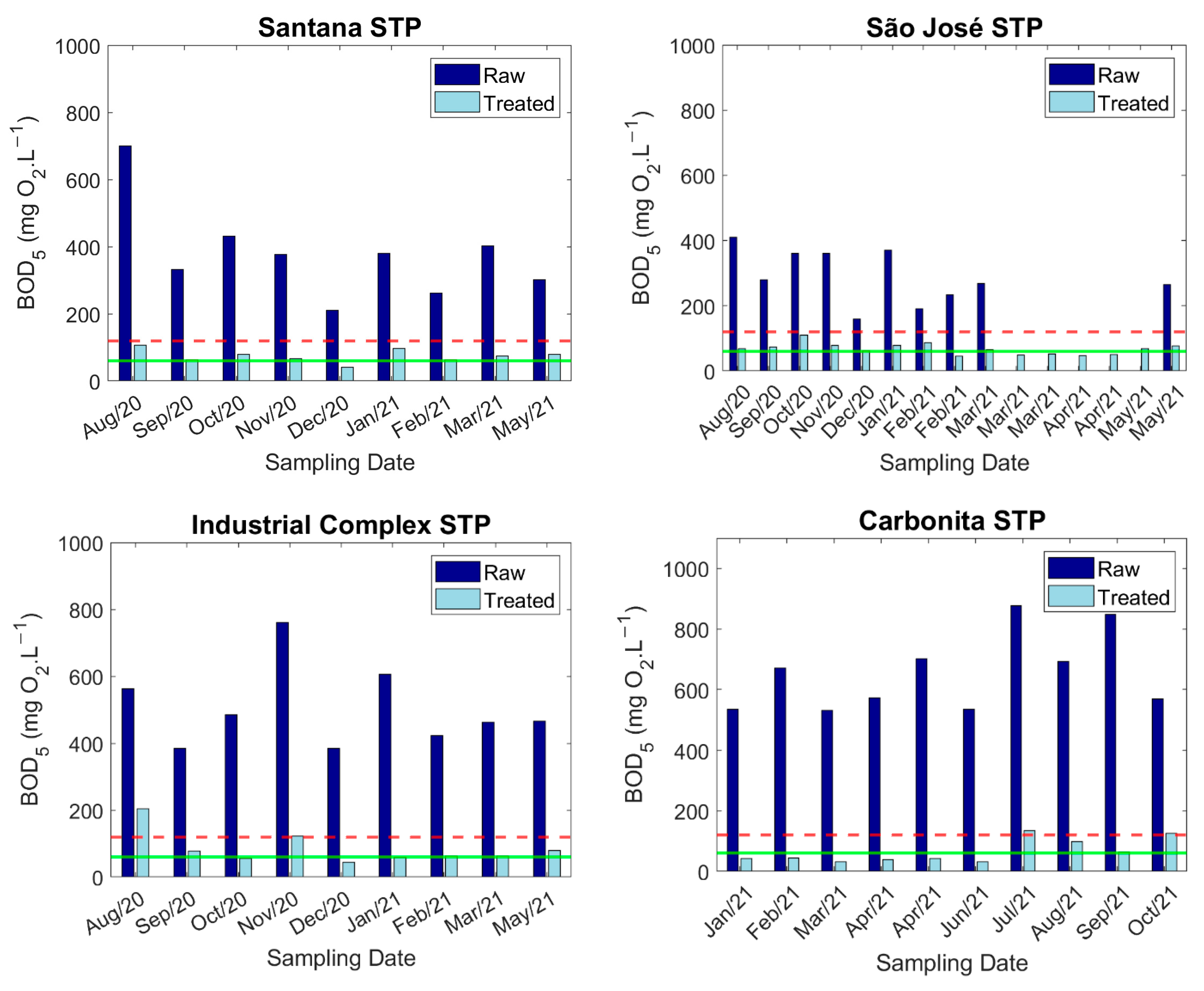
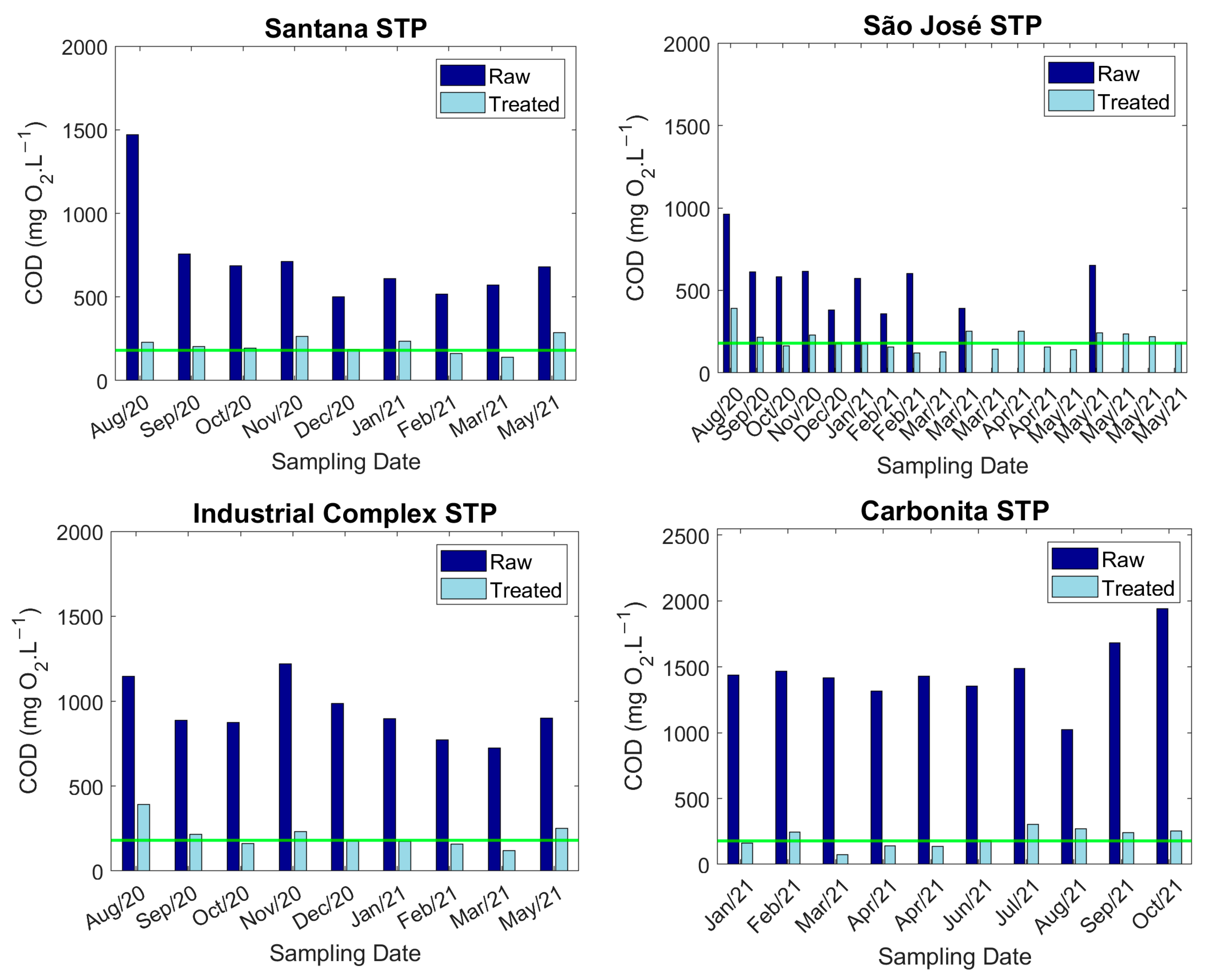
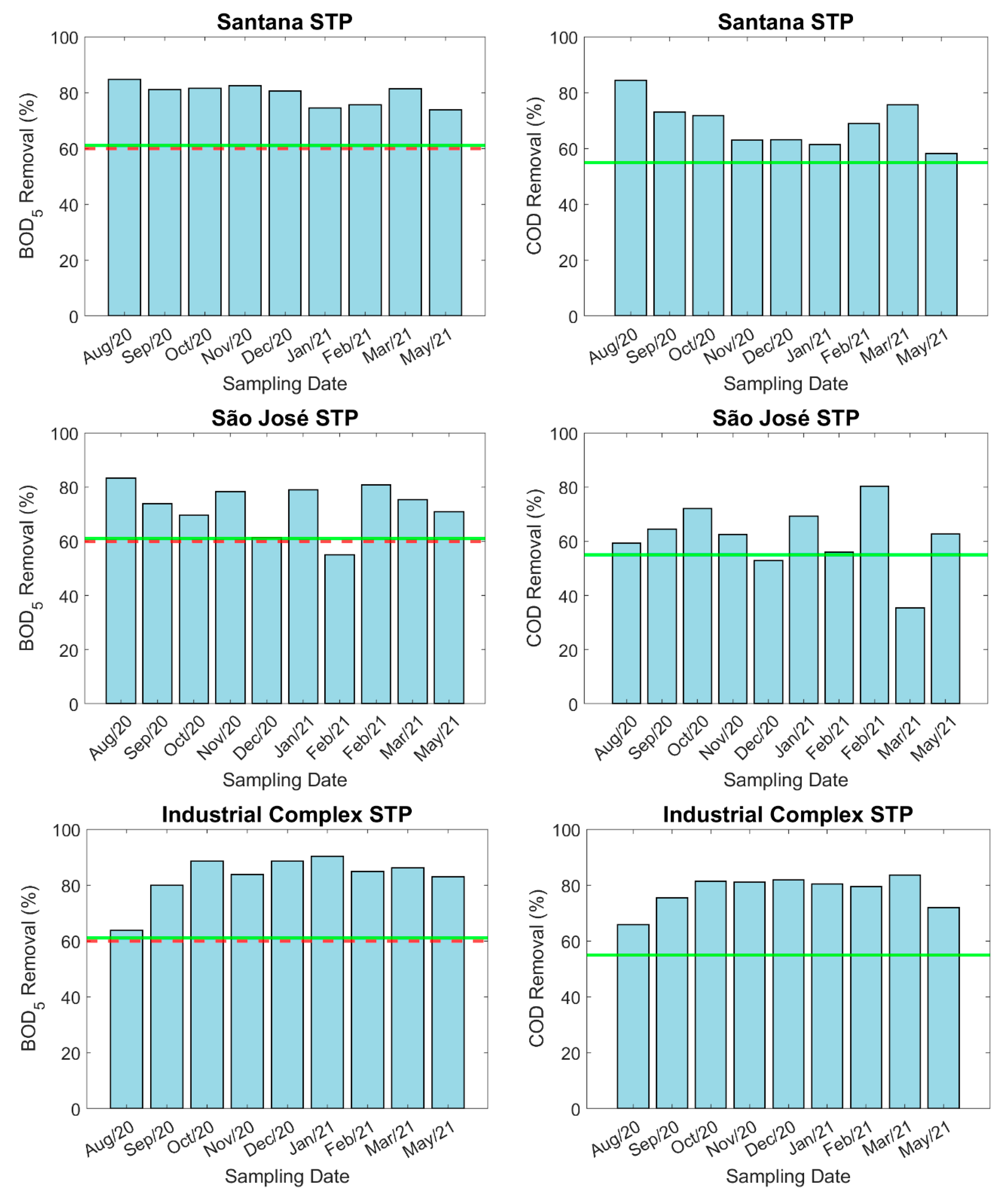


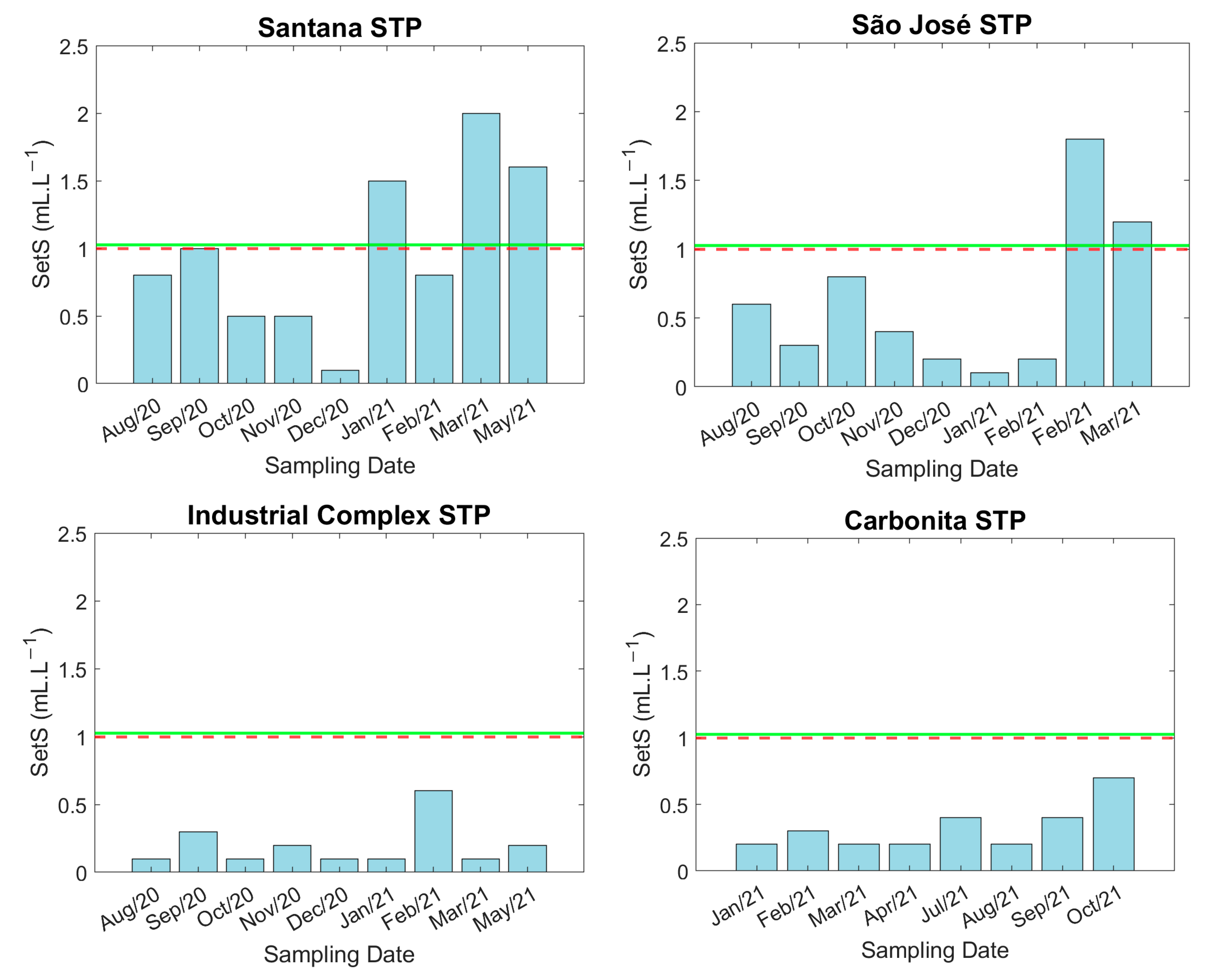
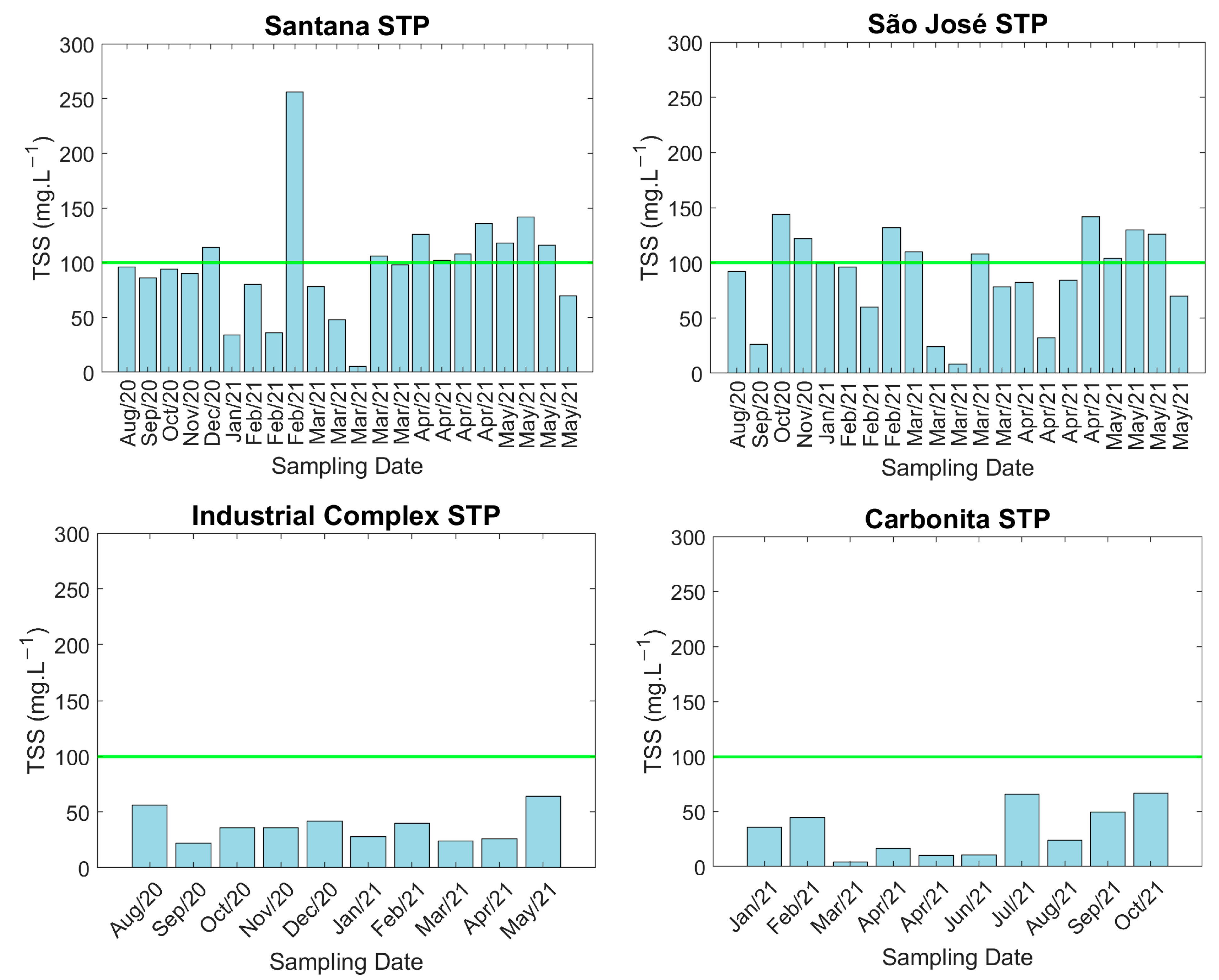
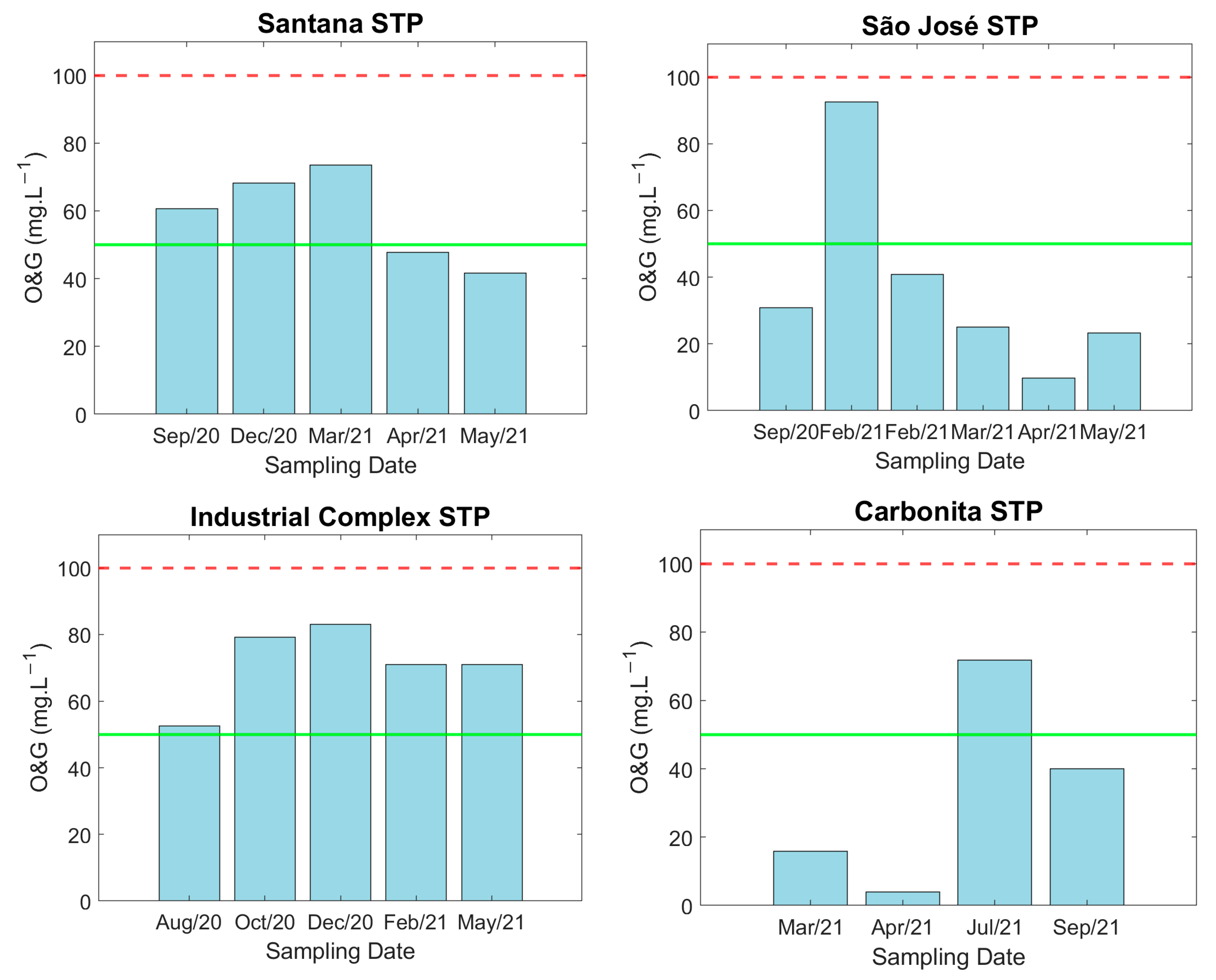
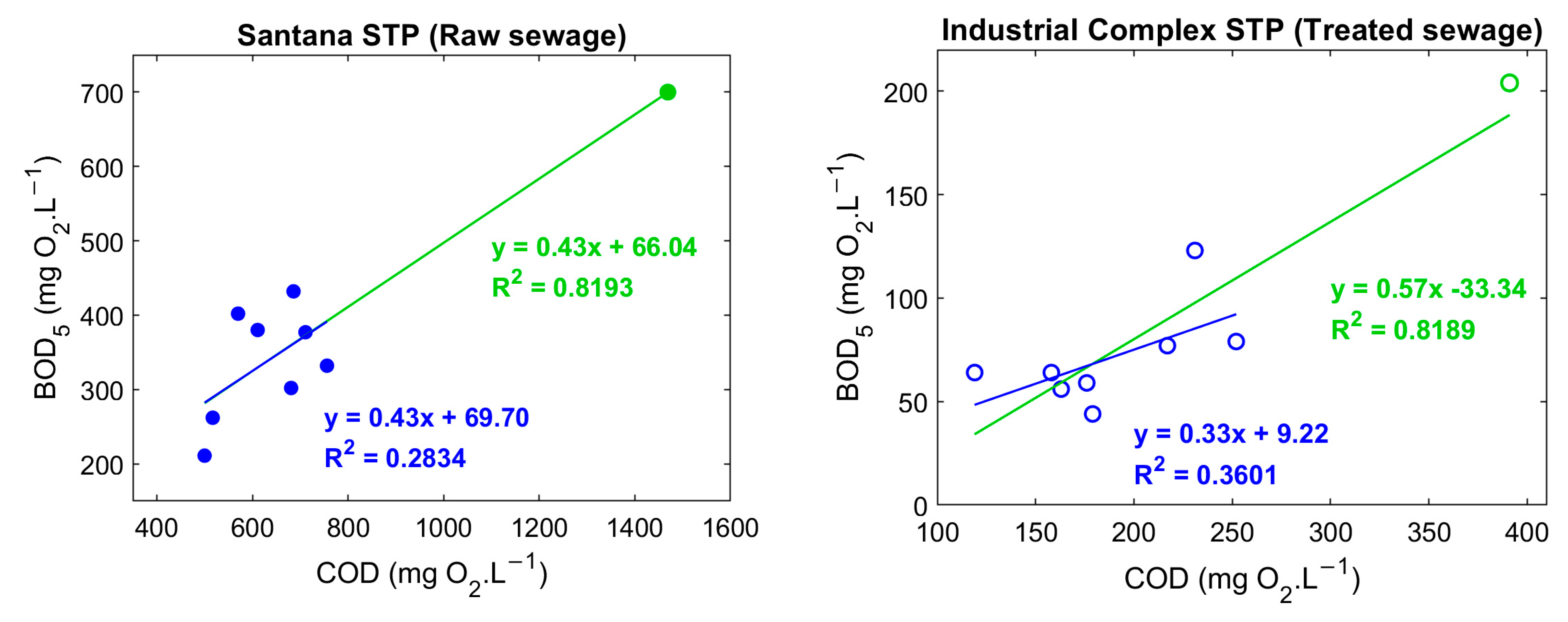

| Parameters | CONAMA 430/2011 [31] | COPAM/CERH-MG 01/2008 [32] | CERH-MG 65/2020 [33] | ABNT NBR 16783/2019 [34] |
|---|---|---|---|---|
| BOD5 (mg.L−1) | <120 or minimum removal of 60% | <60 or minimum removal of 60% | – | <20 |
| COD (mg.L−1) | – | <180 or minimum removal of 55% | – | – |
| pH | 5.0–9.0 | 6.0–9.0 | 6.0–9.0 | 6.0–9.0 |
| SetS (mL.L−1) | <1 | <1 | – | – |
| TSS (mg.L−1) | – | <100 | – | – |
| O&G (mg.L−1) | <100 | <50 | – | – |
| Thermotolerant coliforms or Escherichia coli (NMP.100 mL−1) | – | – | ≤1 × 104 *; ≤ 1 × 106 ** | ≤2 × 102 |
| Viable helminth eggs (number of eggs.L−1) | – | – | ≤1 | – |
| City | Population (Thousand Inhabitants) | STP Name | Current Average Operating Flow Rate (L.s−1) | Maximum Allowed Flow Rate (L.s−1) | Sewage Treatment Processes | Receiving Water Body | Reference |
|---|---|---|---|---|---|---|---|
| Varginha | 136.4 | Santana | 96.6 | 280.0 | Screening, desander, 4 UASB reactors | Verde River | [28,36,40,41,42] |
| São José | 66.3 | 229.0 | Screening, desander, 4 UASB reactors | ||||
| Industrial Complex | 0.49 | 3.3 | Screening, desander, 2 UASB reactors, 4 aeration tanks and 1 decanter (activated sludge system) | ||||
| Carbonita | 8.5 | Carbonita | 13.43 | 13.43 | Screening, desander, 2 UASB reactors, 2 up-flow anaerobic filters, surface runoff in the soil | Curralinho Stream | [29,38,43] |
| Parameters | Number of Samples | Average | Standard Deviation | CV (%) | Minimum | Maximum | p-Value |
|---|---|---|---|---|---|---|---|
| Santana STP | |||||||
| BOD5 (mg.L−1) | 9 | 74.7 | 19.5 | 26.1 | 41.0 | 107.0 | 0.674 |
| COD (mg.L−1) | 9 | 210.5 | 47.4 | 22.5 | 139 | 285 | 0.973 |
| BOD5 removal (%) | 9 | 79.5 | 3.9 | 4.9 | 73.8 | 84.7 | 0.089 |
| COD removal (%) | 9 | 68.8 | 8.3 | 12.1 | 58.1 | 84.4 | 0.663 |
| SetS (mL.L−1) | 9 | 0.98 | 0.60 | 61.2 | 0.1 | 2.0 | 0.624 |
| SST (mg.L−1) | 22 | 97.2 | 49.3 | 50.7 | 5 | 256 | 0.038 |
| O&G (mg.L−1) | 5 | 58.4 | 13.4 | 23.0 | 41.7 | 73.6 | 0.668 |
| São José STP | |||||||
| BOD5 (mg.L−1) | 15 | 67.4 | 17.6 | 26.1 | 45 | 110 | 0.345 |
| COD (mg.L−1) | 22 | 208.6 | 68.3 | 32.7 | 119 | 391 | 0.068 |
| BOD5 removal (%) | 10 | 72.7 | 8.9 | 12.2 | 55.0 | 83.2 | 0.352 |
| COD removal (%) | 10 | 61.5 | 12.1 | 19.6 | 35.4 | 80.2 | 0.564 |
| SetS (mL.L−1) | 10 | 0.62 | 0.18 | 29.0 | 0,1 | 1.8 | 0.105 |
| SST (mg.L−1) | 21 | 89.0 | 40.2 | 45.2 | 8 | 144 | 0.261 |
| O&G (mg.L−1) | 6 | 37.0 | 29.0 | 78.4 | 9,8 | 92.6 | 0.068 |
| Industrial Complex STP | |||||||
| BOD5 (mg.L−1) | 9 | 85.5 | 49.7 | 58.1 | 44 | 204 | 0.005 |
| COD (mg.L−1) | 9 | 209.5 | 79.3 | 37.8 | 119 | 391 | 0.107 |
| BOD5 removal (%) | 9 | 83.2 | 8.0 | 9.6 | 63.7 | 90.2 | 0.015 |
| COD removal (%) | 9 | 77.9 | 5.7 | 7.3 | 65.9 | 83.6 | 0.058 |
| SetS (mL.L−1) | 9 | 0.2 | 0.2 | 100.0 | 0.1 | 0.6 | <0.005 |
| SST (mg.L−1) | 10 | 37.4 | 13.8 | 36.9 | 22 | 64 | 0.305 |
| O&G (mg.L−1) | 5 | 71.3 | 11.7 | 16.4 | 52.6 | 83.1 | 0.313 |
| Carbonita STP | |||||||
| BOD5 (mg.L−1) | 10 | 65.2 | 39.5 | 60.6 | 31 | 104.6 | 0.014 |
| COD (mg.L−1) | 10 | 200.4 | 72.8 | 36.3 | 73 | 257.2 | 0.527 |
| BOD5 removal (%) | 10 | 90.2 | 5.5 | 6.1 | 77.9 | 94.2 | <0.005 |
| COD removal (%) | 10 | 85.9 | 5.9 | 6.9 | 73.6 | 94.8 | 0.448 |
| SetS (mL.L−1) | 8 | 0.32 | 0.18 | 56.2 | 0.2 | 0.7 | 0.022 |
| SST (mg.L−1) | 10 | 32.8 | 23.1 | 70.4 | 4.2 | 66.7 | 0.414 |
| O&G (mg.L−1) | 4 | 32.87 | 30.0 | 91.3 | 3.9 | 71.8 | 0.617 |
Disclaimer/Publisher’s Note: The statements, opinions and data contained in all publications are solely those of the individual author(s) and contributor(s) and not of MDPI and/or the editor(s). MDPI and/or the editor(s) disclaim responsibility for any injury to people or property resulting from any ideas, methods, instructions or products referred to in the content. |
© 2025 by the authors. Licensee MDPI, Basel, Switzerland. This article is an open access article distributed under the terms and conditions of the Creative Commons Attribution (CC BY) license (https://creativecommons.org/licenses/by/4.0/).
Share and Cite
Lima, J.P.P.; Aguiar, A. Evaluating the Performance of Sewage Treatment Plants Containing Up-Flow Anaerobic Sludge Blanket Reactors Followed or Not by Post-Treatments. Environments 2025, 12, 146. https://doi.org/10.3390/environments12050146
Lima JPP, Aguiar A. Evaluating the Performance of Sewage Treatment Plants Containing Up-Flow Anaerobic Sludge Blanket Reactors Followed or Not by Post-Treatments. Environments. 2025; 12(5):146. https://doi.org/10.3390/environments12050146
Chicago/Turabian StyleLima, Juan Pablo Pereira, and André Aguiar. 2025. "Evaluating the Performance of Sewage Treatment Plants Containing Up-Flow Anaerobic Sludge Blanket Reactors Followed or Not by Post-Treatments" Environments 12, no. 5: 146. https://doi.org/10.3390/environments12050146
APA StyleLima, J. P. P., & Aguiar, A. (2025). Evaluating the Performance of Sewage Treatment Plants Containing Up-Flow Anaerobic Sludge Blanket Reactors Followed or Not by Post-Treatments. Environments, 12(5), 146. https://doi.org/10.3390/environments12050146







